Additional Problems 3
Visualizing Chemistry
Problem 3-19
Identify the functional groups in the following substances, and convert each drawing into a molecular formula (red = O, blue = N).
(a)
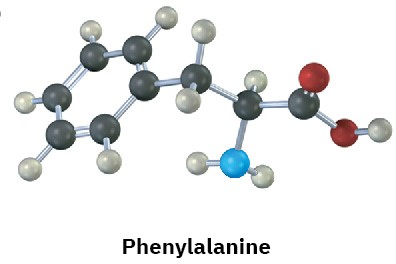
(b)
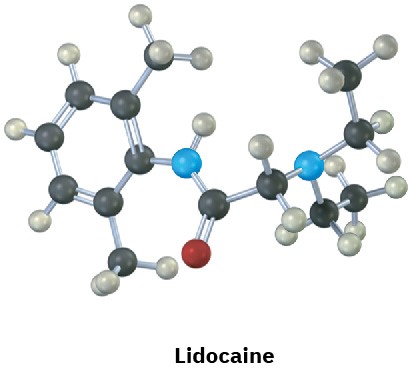
Problem 3-20
Give IUPAC names for the following alkanes, and convert each drawing into a skeletal structure.
(a)
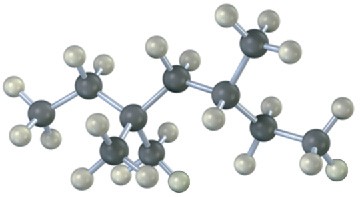
(b)
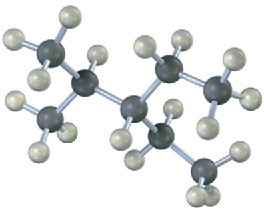
(c)
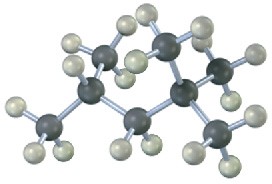
(d)
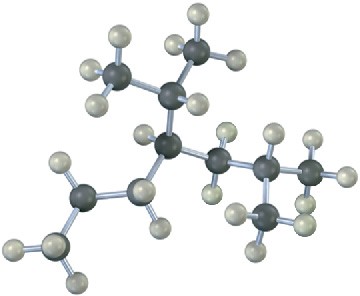
Problem 3-21
Draw a Newman projection along the C2–C3 bond of the following conformation of 2- butanol.
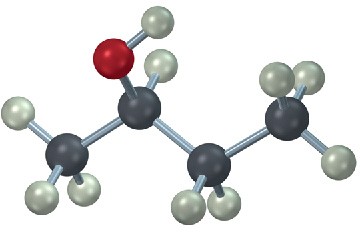
Functional Groups
Problem 3-22
Locate and identify the functional groups in the following molecules. ‘
(a)
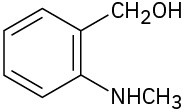
(b)
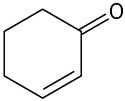
(c)
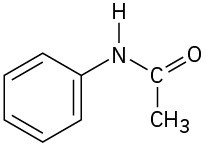
(d)
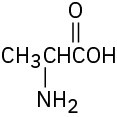
(e)
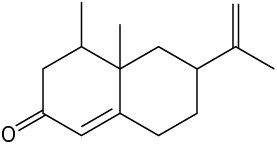
(f)
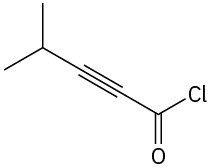
Problem 3-23
Propose structures that meet the following descriptions:
(a) A ketone with five carbons
(b) A four-carbon amide
(c) A five-carbon ester
(d) An aromatic aldehyde
(e) A keto ester
(f) An amino alcohol
Problem 3-24
Propose structures for the following:
(a) A ketone, C4H8O
(b) A nitrile, C5H9N
(c) A dialdehyde, C4H6O2
(d) A bromoalkene, C6H11Br
(e) An alkane, C6H14
(f) cyclic saturated hydrocarbon, C6H12
(g) A diene (dialkene), C5H8
(h) A keto alkene, C5H8O
Problem 3-25
Predict the hybridization of the carbon atom in each of the following functional groups:
(a) Ketone (b) Nitrile (c) Carboxylic acid
Problem 3-26
Draw the structures of the following molecules:
(a) Biacetyl, C4H6O2, a substance with the aroma of butter; it contains no rings or carbon– carbon multiple bonds.
(b) Ethylenimine, C2H5N, a substance used in the synthesis of melamine polymers; it contains no multiple bonds.
(c) Glycerol, C3H8O3, a substance isolated from fat and used in cosmetics; it has an –OH group on each carbon.
Isomers
Problem 3-27
Draw structures that meet the following descriptions (there are many possibilities):
(a) Three isomers with the formula C8H18
(b) Two isomers with the formula C4H8O2
Problem 3-28
Draw structures of the nine isomers of C7H16.
Problem 3-29
In each of the following sets, which structures represent the same compound and which represent different compounds?
(a)

(b)

(c)

Problem 3-30
Seven constitutional isomers have the formula C4H10O. Draw as many as you can.
Problem 3-31
Draw as many compounds as you can that fit the following descriptions:
(a) Alcohols with formula C4H10O
(b) Amines with formula C5H13N
(c) Ketones with formula C5H10O
(d) Aldehydes with formula C5H10O
(e) Esters with formula C4H8O2
(f) Ethers with formula C4H10O
Problem 3-32
Draw compounds that contain the following:
(a) A primary alcohol
(b) A tertiary nitrile
(c) A secondary thiol
(d) Both primary and secondary alcohols
(e) An isopropyl group
(f) A quaternary carbon Naming Compounds
Problem 3-33
Draw and name all monobromo derivatives of pentane, C5H11Br.
Problem 3-34
Draw and name all monochloro derivatives of 2,5-dimethylhexane, C8H17Cl.
Problem 3-35
Draw structures for the following:
(a) 2-Methylheptane
(b) 4-Ethyl-2,2-dimethylhexane
(c) 4-Ethyl-3,4-dimethyloctane
(d) 2,4,4-Trimethylheptane
(e) 3,3-Diethyl-2,5-dimethylnonane
(f) 4-Isopropyl-3-methylheptane
Problem 3-36
Draw a compound that:
(a) Has only primary and tertiary carbons
(b) Has no secondary or tertiary carbons
(c) Has no secondary or tertiary carbons
Problem 3-37
Draw a compound that:
(a) Has nine primary hydrogens
(b) Has only primary hydrogens
Problem 3-38
Give IUPAC names for the following compounds:
(a)

(b)
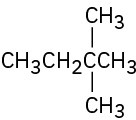
(c)
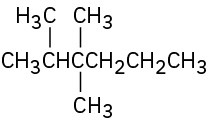
(d)

(e)
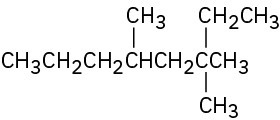
(f)
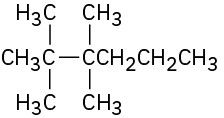
Problem 3-39
Name the five isomers of C6H14.
Problem 3-40
Explain why each of the following names is incorrect:
(a) 2,2-Dimethyl-6-ethylheptane
(b) 4-Ethyl-5,5-dimethylpentane
(c) 3-Ethyl-4,4-dimethylhexane
(d) 5,5,6-Trimethyloctane
(e) 2-Isopropyl-4-methylheptane
Problem 3-41
Propose structures and give IUPAC names for the following:
(a) A diethyldimethylhexane
(b) A (3-methylbutyl)-substituted alkane
Conformations
Problem 3-42
Consider 2-methylbutane (isopentane). Sighting along the C2–C3 bond:
(a) Draw a Newman projection of the most stable conformation.
(b) Draw a Newman projection of the least stable conformation.
(c) If a CH3 ⟷ CH3 eclipsing interaction costs 11 kJ/mol (2.5 kcal/mol) and a CH3 ⟷ CH3 gauche interaction costs 3.8 kJ/mol (0.9 kcal/mol), make a quantitative plot of energy versus rotation about the C2–C3 bond.
Problem 3-43
What are the relative energies of the three possible staggered conformations around the C2–C3 bond in 2,3-dimethylbutane? (See Problem 3-42.)
Problem 3-44
Construct a qualitative potential-energy diagram for rotation about the C–C bond of 1,2- dibromoethane. Which conformation would you expect to be most stable? Label the anti and gauche conformations of 1,2-dibromoethane.
Problem 3-45
Which conformation of 1,2-dibromoethane (Problem 3-44) would you expect to have the largest dipole moment? The observed dipole moment of 1,2-dibromoethane is μ = 1.0 D. What does this tell you about the actual conformation of the molecule?
Problem 3-46
Draw the most stable conformation of pentane, using wedges and dashes to represent bonds coming out of the paper and going behind the paper, respectively.
Problem 3-47
Draw the most stable conformation of 1,4-dichlorobutane, using wedges and dashes to represent bonds coming out of the paper and going behind the paper, respectively.
General Problems
Problem 3-48
For each of the following compounds, draw an isomer that has the same functional groups.
(a)

(b)

(c)

(d)
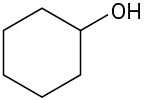
(e)

(f)
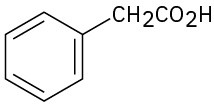
Problem 3-49
Malic acid, C4H6O5, has been isolated from apples. Because this compound reacts with 2 molar equivalents of base, it is a dicarboxylic acid.
(a) Draw at least five possible structures.
(b) If malic acid is a secondary alcohol, what is its structure?
Problem 3-50
Formaldehyde, H2C=O, is known to all biologists because of its usefulness as a tissue preservative. When pure, formaldehyde trimerizes to give trioxane, C3H6O3, which, surprisingly enough, has no carbonyl groups. Only one monobromo derivative (C3H5BrO3) of trioxane is possible. Propose a structure for trioxane.
Problem 3-51
The barrier to rotation about the C–C bond in bromoethane is 15 kJ/mol (3.6 kcal/mol).
(a) What energy value can you assign to an H ↔ Br eclipsing interaction?
(b) Construct a quantitative diagram of potential energy versus bond rotation for bromoethane.
Problem 3-52
Increased substitution around a bond leads to increased strain. Take the four substituted butanes listed below, for example. For each compound, sight along the C2–C3 bond and draw Newman projections of the most stable and least stable conformations. Use the data in Table 3.5 to assign strain-energy values to each conformation. Which of the eight conformations is most strained? Which is least strained?
(a) 2-Methylbutane
(b) 2,2-Dimethylbutane
(c) 2,3-Dimethylbutane
(d) 2,2,3-Trimethylbutane
Problem 3-53
The cholesterol-lowering agents called statins, such as simvastatin (Zocor) and pravastatin (Pravachol), are among the most widely prescribed drugs in the world, with annual sales estimated at approximately $25 billion. Identify the functional groups in both, and tell how the two substances differ.
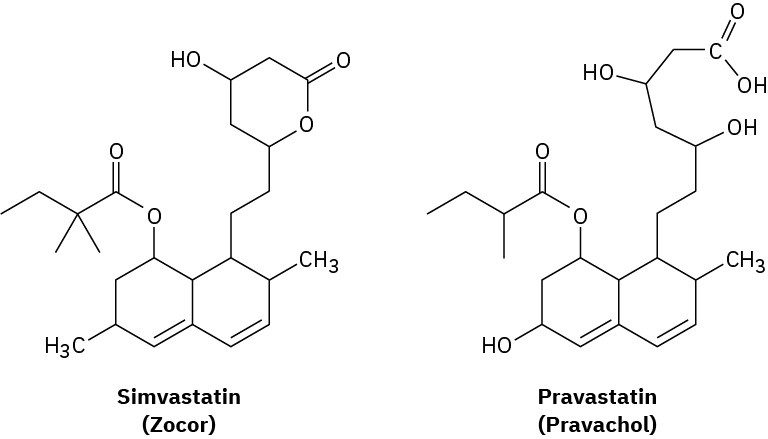
Problem 3-54
In the next chapter we’ll look at cycloalkanes—saturated cyclic hydrocarbons—and we’ll see that the molecules generally adopt puckered, nonplanar conformations. Cyclohexane, for instance, has a puckered shape like a lounge chair rather than a flat shape. Why?
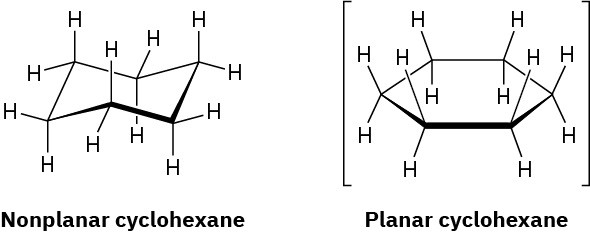
Problem 3-55
We’ll see in the next chapter that there are two isomeric substances, both named 1,2- dimethylcyclohexane. Explain.


